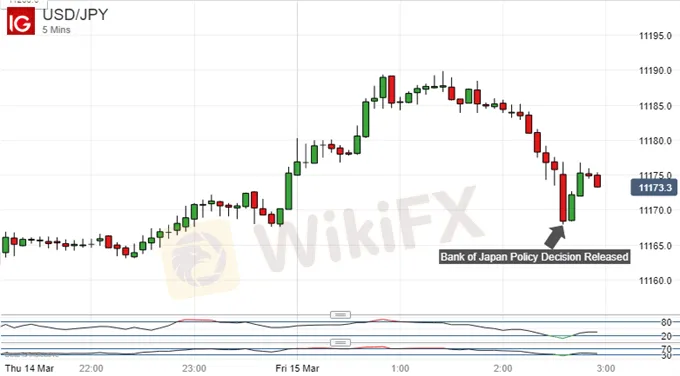简体中文
繁體中文
English
Pусский
日本語
ภาษาไทย
Tiếng Việt
Bahasa Indonesia
Español
हिन्दी
Filippiiniläinen
Français
Deutsch
Português
Türkçe
한국어
العربية
Japanese Yen Weakens Slightly As BoJ Holds Policy, Sounds Gloomier
Abstract:The Japanese Yen faded a little as the central bank left its ultra-accommodative monetary settings alone and worried about an offshore slowdowns effects on Japan.
Japanese Yen, Bank of Japan Monetary Policy Decision, Talking Points:
USD/JPY stopped falling and ticked up after the Bank of Japan announced policy for March
There wasnt much here to surprise however
The central bank still sees modest growth ahead, but frets the global picture
Join our analysts for live, interactive coverage of all major economic data at the DailyFX Webinars. Wed love to have you along.
The Japanese Yen weakened very slightly against the US Dollar Friday after the Bank of Japan left all its monetary policy settings on hold.
That outcome was widely expected in the markets before the fact, but the BoJ also downgraded its assessments of domestic and global prospects. Policymakers noted that Japanese output had been affected by slowdowns elsewhere, with exports showing some recent weakness. It added, however, that the economys modest expansion was likely to continue.
Turning to monetary policy, short-term rates remain steady at -0.1%, and the ten-year Japanese Government Bond yield target remains 0%, with massive quantitative easing still in place in the form of bond buying. Given recent data from around the world there was nothing especially surprising here.
The US Dollar had been falling against the Japanese Yen through the Asian morning as investors fretted about trade tensions between the US and both China and the European Union. That fall stalled after the BoJ announcement.

Meanwhile, USD/JPYs daily chart shows the pair very much still within the uptrend which has dominated trade for much of this year, as risk appetite has in turn held up as investors keep faith that a trade settlement between Washington and Beijing will ultimately reachable.
However, the JPY112.00 handle remains elusive for US Dollar bulls on a daily closing basis, even as they seem to be gearing up for another try at it.

That level will need to be convincingly retaken, however, is the pair is to push on upward to the peaks of mid-December 2018 which now bar the way higher.
Disclaimer:
The views in this article only represent the author's personal views, and do not constitute investment advice on this platform. This platform does not guarantee the accuracy, completeness and timeliness of the information in the article, and will not be liable for any loss caused by the use of or reliance on the information in the article.
Read more

Global Market Volatility Amid Central Bank Decisions and Corporate Earnings
The global market is experiencing significant volatility due to uncertainties in economic data and central bank policies. Key highlights include the Nasdaq 100 index's dramatic rise and fall, Amazon's disappointing sales data, and Japan's significant stock market drop following an unexpected rate hike by the Bank of Japan.

Yen Resurgence! Will Next BoJ Week Sustain the Rally?
The U.S. Conference Board reported a slight decline in the US Consumer Confidence Index (CCI) for June 2024, dropping to 100.4 from 101.3 in May. The Bank of Japan (BoJ) opted to keep its key short-term interest rate steady at 0.10% for June 2024, in line with market expectations. At its June 2024 meeting, the Federal Reserve decided to keep the federal funds rate unchanged at 5.50%. In June 2024, the Bank of England (BoE) decided to keep the interest rate at 5.25% unchanged. This decision...

Dollar Gains on Hawkish Fed Outlook
After digesting Jerome Powell's comments following the FOMC interest rate decision on Wednesday, the dollar erased all its losses from the soft CPI reading, continuing its upward trajectory. The hawkish outlook from the Fed stimulated dollar strength against its peers, while the bullish momentum in equity markets was hindered by the prospect of prolonged high interest rates.

USDJPY Predicted to Rise on Yen Depreciation
The USD/JPY pair is predicted to increase based on both fundamental and technical analyses. Fundamental factors include a potential easing of aggressive bond buying by the Bank of Japan (BoJ), which could lead to yen depreciation. Technical indicators suggest a continuing uptrend, with the possibility of a correction once the price reaches the 157.7 to 160 range.
WikiFX Broker
Latest News
Tokyo Police Arrest 4 for Unregistered FX Trading Scheme
BSP Shuts Down Uno Forex Over Serious AML Violations
ACY Securities Expands Global Footprint with South Africa Acquisition
Rupee gains against Euro
WikiEXPO Global Expert Interview: The Future of Financial Regulation and Compliance
DFSA Warns of Fake Loan Approval Scam Using Its Logo
Consob Sounds Alarm: WhatsApp & Telegram Users Vulnerable to Investment Scams
CySEC Revokes UFX Broker Licence as Reliantco Halts Global Operations
GCash, Government to Launch GBonds for Easy Investments
Bitcoin ETF Options Get Closer to Reality with CFTC Clarification
Currency Calculator


